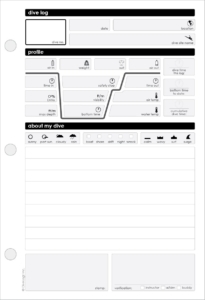A dive log is an essential record-keeping tool used in scuba diving. For over a half-century, recreational and professional divers from across the world have used them to record their underwater adventures. After resurfacing, a diver can complete the given fields in a dive log to document his or her experience. The creation of these dive logs offers a journal that divers can reference to assess their past dives.
If you’re new to scuba diving, you might be wondering how to use a dive log. Experienced divers are usually familiar with dive logs, allowing them to quickly and easily complete them. But for newcomers to scuba diving, dive logs can be confusing. By familiarizing yourself with the basic elements of a dive log, though, you can take advantage of this tool and the unique benefits that it offers.
What Is a Dive Log?
 A dive log is a document detailing the conditions and events of a single, specific dive. It features various fields that you can complete to record your diving experience. While different dive logs have different fields and formatting, they all serve the same underlying purpose of recording your dives. When you go diving, you should complete a dive log to create a journal of your experience.
A dive log is a document detailing the conditions and events of a single, specific dive. It features various fields that you can complete to record your diving experience. While different dive logs have different fields and formatting, they all serve the same underlying purpose of recording your dives. When you go diving, you should complete a dive log to create a journal of your experience.
In a dive log, you can record information about a dive, such as the date and location, equipment used, maximum depth, air usage, average depth, bottom time, water temperature, current conditions and more. Even if you have a sharp memory, you probably won’t remember everything about a dive. A dive log allows you to create an accurate record of your dives, which you can use to plan your future dives and, ultimately, become a better diver.
Common Sections of a Dive Log
A standard, non-commercial dive log may contain the six following sections:
- Header: Found at the top of the dive log, the header features fields for basic information about the dive, such as the dive number, location, date and time.
- Profile: Perhaps the most important section, the profile is used to record information such as bottom time, depth, saturation levels and air usage.
- Equipment: As the name suggests, the equipment section is used to record information about the equipment used during the dive. Among other things, you can use this section to record how much weight you used, whether the weights were belt or BCD, size of air tank, material of air tank, wetsuit material and wetsuit thickness.
- Conditions: In the conditions section, you can include information about the environmental conditions of the dive, including the water temperature, saltwater vs freshwater, underwater visibility and day vs night.
- Comments: Most dive logs feature a comments section where you can include your notes about the dive. Maybe you felt uncomfortably cold during the dive, or perhaps you found the area difficult to navigate. Regardless, you can record these and other thoughts about the dive in the comments section. Some divers also use this section to record the types of fish and marine life they encountered so that they’ll remember which diving locations offered the best experience.
- Verification: Also known as the validation section, the verification section is used to verify your dive by a third party. After completing your dive log, you can ask your diving instructor, divemaster or even a buddy to verify your dive in this section. The individual can sign his or her name to verify your dive. With that said, many diving instructors and divemasters use stamps as an alternative to signatures.
In addition to these six sections, dive log books — books featuring dozens or hundreds of individual dive log pages — often feature a separate section for emergency contact and medical information. In this section, you can include the name, address, phone number of an emergency contact, as well as your blood type, any allergies from which you suffer and any medication that you are currently taking.
Hopefully, this doesn’t happen, but if you are injured or otherwise experience a medical injury while diving, the information contained in this section could prove vital towards your treatment and recovery efforts. The dive charter can provide emergency medical professionals with your dive log book to ensure you receive the possible treatment.
When to Use a Dive Log
 Unless you’re a professional diver, you aren’t legally required to use a dive log. However, it’s still a good idea to use dive logs because it creates a record of your past dives. No two dives are ever the same, and without dive logs, you may struggle to remember key information about your past dives.
Unless you’re a professional diver, you aren’t legally required to use a dive log. However, it’s still a good idea to use dive logs because it creates a record of your past dives. No two dives are ever the same, and without dive logs, you may struggle to remember key information about your past dives.
Assuming you dive for recreational or leisure purposes, you can omit certain dives from your dive logs. Many divers, for example, follow the 20-20 rule when using dive logs, which states that only dives 20 feet or deeper with a duration of 20 minutes or longer should be recorded in a dive log. For shallower and/or shorter dives, the information isn’t recorded because it’s not considered a substantial dive.
So, when should you use a dive log? You can either use one with every dive, or you can follow the 20-20 rule. As a beginner, though, completing a dive log for each dive will help you learn the various fields and what they mean. As you become accustomed to using dive logs, you can then switch to the 20-20 rule by only recording dives in which you descent to at least 20 feet and stay underwater for at least 20 minutes.
How to Use a Dive Log
To use a dive log, simply complete all relevant and meaningful fields during your diving trip. While boating out to your dive site, you can go ahead and complete some of the fields in your dive sheet, such as the location and equipment. For others, you’ll have to wait until you resurface to complete them.
But don’t wait too long after resurfacing to complete your dive log. By completing the rest of your dive log immediately or shortly after you resurface, you should remember all the essential information about the dive, which you can include in your dive log. If you wait until the next day to complete your dive log, you may forget details about the dive, thereby reducing the value of this record-keeping tool. Furthermore, if you want your dive log verified — something that’s necessary when seeking certification — a diving instructor, divemaster or buddy must sign or stamp it. To prevent headaches such as this, complete your dive log as soon as possible after you resurface.
When In Doubt, Ask for Help
Don’t be afraid to seek help if you have a question about a particular field or section in a dive log. Most dive charters will gladly offer assistance with your dive log. They can explain what the different fields mean as well as the information to include those fields.
Whether you’re still training for scuba certification, or if you’ve been certified for years, you should get into the habit of using dive logs. Dive logs offer more than just a reference of your past dives. They serve as a journal detailing the unique experience of each dive.
Want to create your own custom dive logs? Contact us today to learn more about our custom dive logs.



